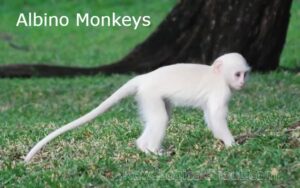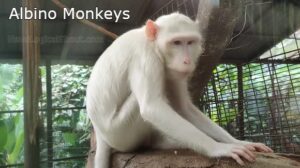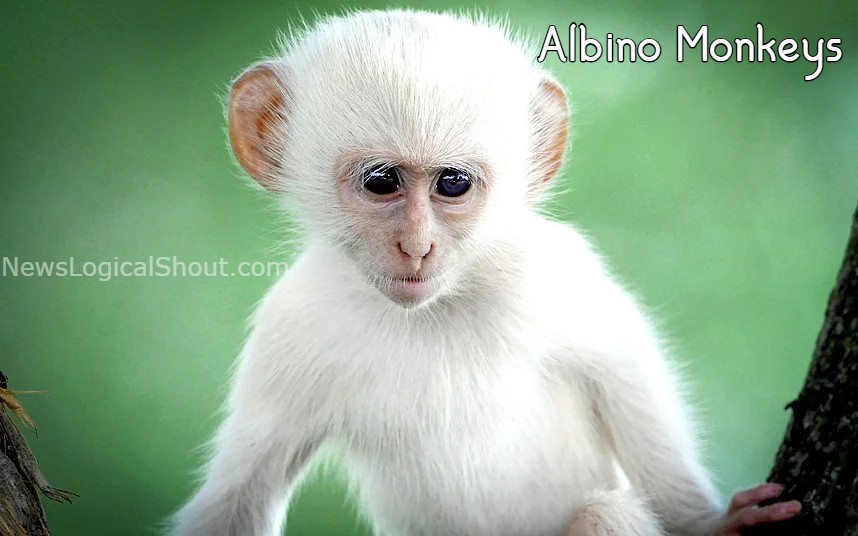Albino monkeys are a rare and fascinating phenomenon in the animal kingdom. Characterized by their striking white fur and pinkish skin, these monkeys stand out in the wild due to their lack of pigmentation.
The occurrence of albino monkeys is rare, making them an intriguing subject for both researchers and animal enthusiasts.
In this article, we’ll explore the beauty, rarity, and conservation efforts related to albino monkeys, shedding light on their unique characteristics and the challenges they face in the wild.
What Are Albino Monkeys?
Albino monkeys are monkeys born with a genetic condition called albinism, which causes a lack of pigmentation in their fur and skin.
This absence of color makes them appear white or pale, with pinkish eyes, skin, and sometimes even their fur.
Albinism occurs when both parents carry a recessive gene for the condition, resulting in the offspring inheriting two copies of the gene.
This leads to a lack of melanin, the pigment responsible for the color in an animal’s skin, hair, and eyes.
These monkeys are not a separate species; rather, they are a rare variation found among certain species of monkeys, including macaques, baboons, and capuchins.
Albino monkeys are often seen as a unique and rare sight in the wild due to their striking appearance.
The Beauty of Albino Monkeys
The beauty of albino monkeys lies in their striking appearance. Their white or pale fur, pinkish skin, and often red or light-colored eyes create a visually stunning contrast against the usual darker monkeys they live among.
This unusual coloration often attracts attention from both humans and other animals.While the albino monkey’s appearance is stunning, it also has biological implications.
The lack of pigmentation makes albino monkeys more sensitive to sunlight, which can lead to skin damage and a higher risk of sunburn.
Additionally, their lighter fur may make them more visible to predators in the wild, potentially making it harder for them to blend in with their surroundings.
Why Are Albino Monkeys So Rare?

The rarity of albino monkeys is due to the genetic nature of albinism. As a recessive genetic trait, both parents must carry the gene for the condition in order for an albino offspring to be born.
This means that albino monkeys are extremely rare in the wild, especially considering that many monkey populations do not have widespread occurrences of this genetic mutation.
In the wild, the chances of two monkeys with the albinism gene mating are low, further contributing to the rarity of albino monkeys.
As a result, these monkeys are often seen as a rare spectacle by researchers and wildlife enthusiasts.
The Challenges of Albino Monkeys in the Wild
While albino monkeys are beautiful to behold, their lack of pigmentation presents a number of challenges in the wild. For starters, their visibility makes them an easy target for predators.
In dense forests or other environments where camouflage is essential for survival, albino monkeys are at a disadvantage because their pale coloration stands out against the green foliage or earthy surroundings.
Additionally, the absence of melanin, which provides protection against the sun’s harmful UV rays, makes albino monkeys more susceptible to skin damage.
This can result in sunburn, which, if left untreated, can cause long-term health issues. Albino monkeys are also more vulnerable to eye problems due to their lack of melanin in the eyes, which are necessary for protecting them from bright light.
Albino Monkeys in Captivity: Challenges and Care
Albino monkeys in captivity face unique challenges as well. While they may be protected from natural predators, they still require special care to manage their sensitive skin and eyes.
Captive albino monkeys are often provided with shelter and sun protection, such as shaded enclosures, to reduce their risk of sunburn.
Zookeepers and wildlife experts also provide albino monkeys with appropriate diets to support their health.
These monkeys require regular health checkups, as their sensitive skin and eyes make them more prone to infections or other medical conditions.
However, even in captivity, albino monkeys often face difficulty reproducing due to the genetic rarity of albinism. As a result, these monkeys are rarely bred in zoos or sanctuaries, and their numbers remain low.
Albino Monkeys and Their Role in the Ecosystem
Like other monkeys, albino monkeys play an important role in their ecosystems. Monkeys, in general, help to maintain the balance of their habitats by spreading seeds, pollen, and participating in the food chain.
They are essential for the regeneration of plant life and maintaining the biodiversity of their environments.
Albino monkeys, despite their rare appearance, contribute in the same way. They forage for food, help with seed dispersal, and engage in social behaviors that are crucial to their species.
However, their vulnerability due to their lack of camouflage and sensitivity to sunlight can affect their ability to perform these roles effectively in the wild.
Conservation Efforts to Protect Albino Monkeys

The conservation of albino monkeys, like other rare species, is vital for ensuring their survival.
Since albino monkeys are a rare genetic occurrence, their conservation efforts often overlap with those aimed at protecting the general population of their species.
This includes habitat preservation, reducing hunting, and ensuring that monkeys have access to food and water sources.
In many regions, conservation organizations work to protect the natural habitats of monkeys, ensuring that forests and other ecosystems remain undisturbed.
By preserving these environments, they help maintain the delicate balance needed for all monkey species, including albino monkeys, to thrive.
Additionally, researchers are studying albinism in monkeys and other animals to better understand its genetic implications and ensure that the rare condition does not negatively impact the health of albino monkeys in the wild.
How Can We Help Protect Albino Monkeys?
There are several ways in which individuals can help protect albino monkeys and support conservation efforts.
One of the most effective ways is through supporting conservation organizations and initiatives that focus on protecting monkey habitats.
Donations and volunteer work can go a long way in helping these organizations carry out their important work.
Another way to help is by spreading awareness about the plight of albino monkeys and other endangered species.
By raising awareness, we can encourage people to take action to protect wildlife and prevent the destruction of natural habitats.
Finally, reducing our carbon footprint and supporting sustainable practices can help preserve the ecosystems where albino monkeys and other animals live.
By being mindful of our impact on the environment, we contribute to the preservation of the habitats that these rare monkeys rely on.
The Future of Albino Monkeys
The future of albino monkeys depends largely on the continued conservation efforts and the protection of their habitats.
While their rare appearance makes them a unique part of the animal kingdom, albino monkeys face significant challenges that could threaten their survival.
Climate change, habitat loss, and poaching all pose risks to the continued existence of these rare creatures.
By supporting conservation efforts, raising awareness, and protecting the environments where albino monkeys live, we can ensure that these beautiful creatures continue to exist for generations to come.
The rarity and beauty of albino monkeys make them an important symbol of wildlife conservation, reminding us of the delicate balance between nature and the creatures that inhabit it.
Conclusion
Albino monkeys are a rare and stunning example of nature’s diversity. Their beauty, though captivating, comes with challenges due to their genetic condition and vulnerability in the wild.
The conservation of these monkeys is crucial to ensuring their survival, as well as the overall health of their ecosystems.
By supporting conservation efforts and spreading awareness, we can help protect albino monkeys and ensure that future generations can marvel at these incredible creatures.


